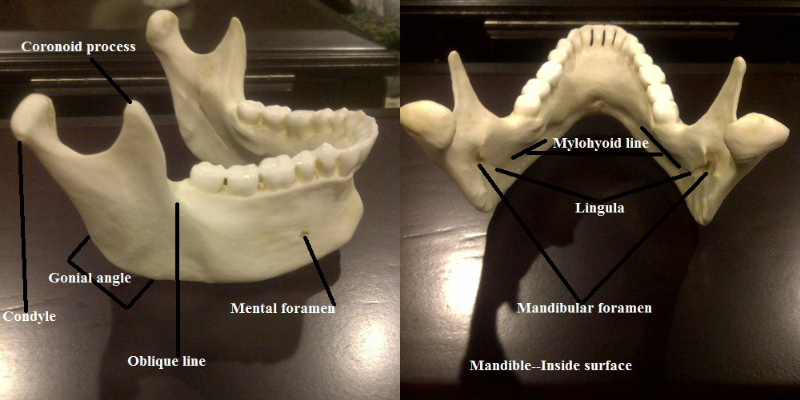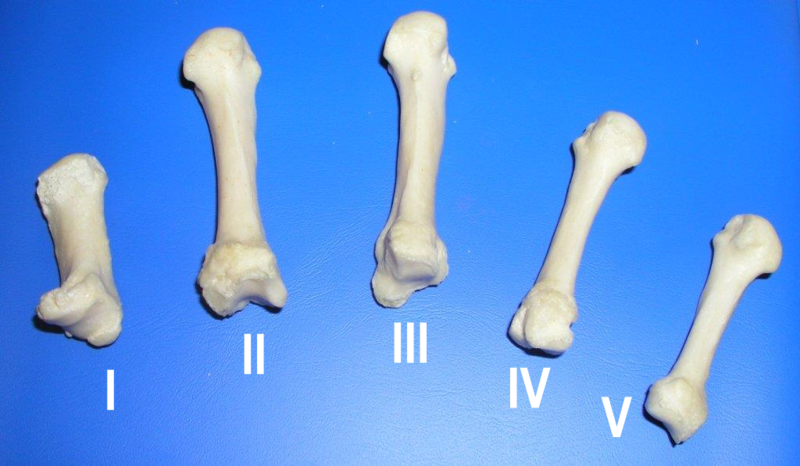Mandibles and Metacarpals
Mandible

One of my favorite bones in the human body is the mandible, colloquially known as the jawbone, because it's so distinctive that it simply cannot be mistaken for any other bone. It sits snugly in the temporomandibular joints on either side of the temporal bones of your skull, and if you've ever opened your mouth too wide and heard and felt a click, that was your mandible moving in its joints.
Aside from its aesthetic value, it has quite a few important functions. Forensic anthropologists and bioarchaeologists can use the mandible to sex the decedent, as male and female mandibles differ in fairly predictable ways. In general, male mandibles are larger, rougher, squarer, and have more pronounced muscle attachment sites than female mandibles, which are usually rounded and more gracile (delicate). There are anomalies, of course, but these are the general characteristics that we use. The mandible, along with the maxilla (upper jaw), holds the teeth in place and anchors some muscles of mastication, so without it, you could not chew your food. What you may not know is that the mandible is actually made of two halves, called the hemimandibles ("half mandible" in Latin), that fuse together when you're a child, just like your cranial bones do. This site of fusion is called the mandibular symphysis, where a remnant of the mandible's split past remains in the form of a suture--a thin line down the middle of the bone.
The mandible is one of the easiest bones to identify, even in fragmental form, as it has plenty of very distinctive details. Obviously, we all know what a whole mandible looks like, with its curved, horizontal ramus, or body. But there are other fun bits. The (mandibular) condyles are the knob-like projections that sit in the temporomandibular joints, and when connected, the whole thing looks sort of like a hinge. The two coronoid processes are the slightly pointier projections that slope distally (away from the body) from the condyles. They anchor the temporalis muscle. The alveolar processes hold the teeth, and the gonial angles are the two bases of the mandible that give certain men (e.g. Richard Armitage) the much-lauded chiseled, square jaw. On the outside of the bone are the mental foramen--a hole for arteries, veins, and nerves, the mandibular symphysis, and the oblique line, while on the inside surface are the mandibular foramen, the lingula, and the mylohyoid line--where the mylohyoid muscle lays. Osteologists rely on these and other anatomical features to identify fragmented mandibles.
Metacarpals

If the mandible is one of my favorite bones, the metacarapals have got to be one of my least favorite. Sitting between the carpals (wrist bones) and the manual phalanges (fingers), metacarpals are the hand's equivalent to the foot's metatarsals, which I also dislike. There are five in each hand, and they are numbered as such, with M1 being the thumb and M5 being the pinky. Each metacarpal consists of three parts, the base (articulates with the wrist bones), body (intermediate part), and head (articulates with the fingers).
Although I don't contest that metacarpals are important, I do maintain that they are one of the hardest skeletal elements to side. Identifying them is simple, and differentiating them from the metatarsals isn't hard either, as they're smaller. Even figuring out M2 from M4 is a piece of cake, as each of the five metacarpals has its own unique feature (M5, for example, has a little spike on its base). But what really fouled me up while studying them was having to determine which side of the body they came from. I tended to confuse which side the metacarpal's anatomical feature was on. For instance, M5's little spike is on the distal side, meaning it's away from the body. But you have to first position the bone with the correct surface facing up, or else M5's spike will be on the wrong side. It was determining which surface was right-side-up that gave me grief, but with enough practice and staring at the bones (and sometimes cursing at them), I eventually got the hang of it. Now metacarpals (and metatarsals) and I have formed a tenuous truce.






